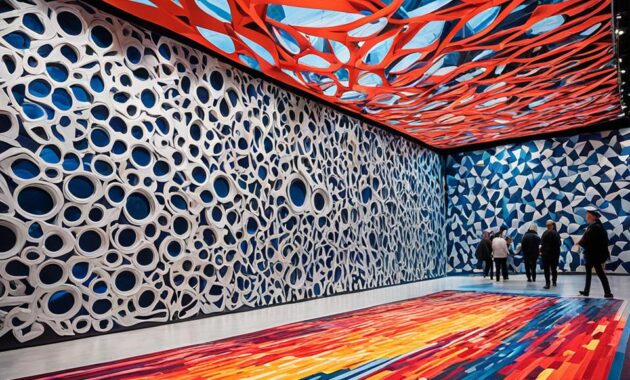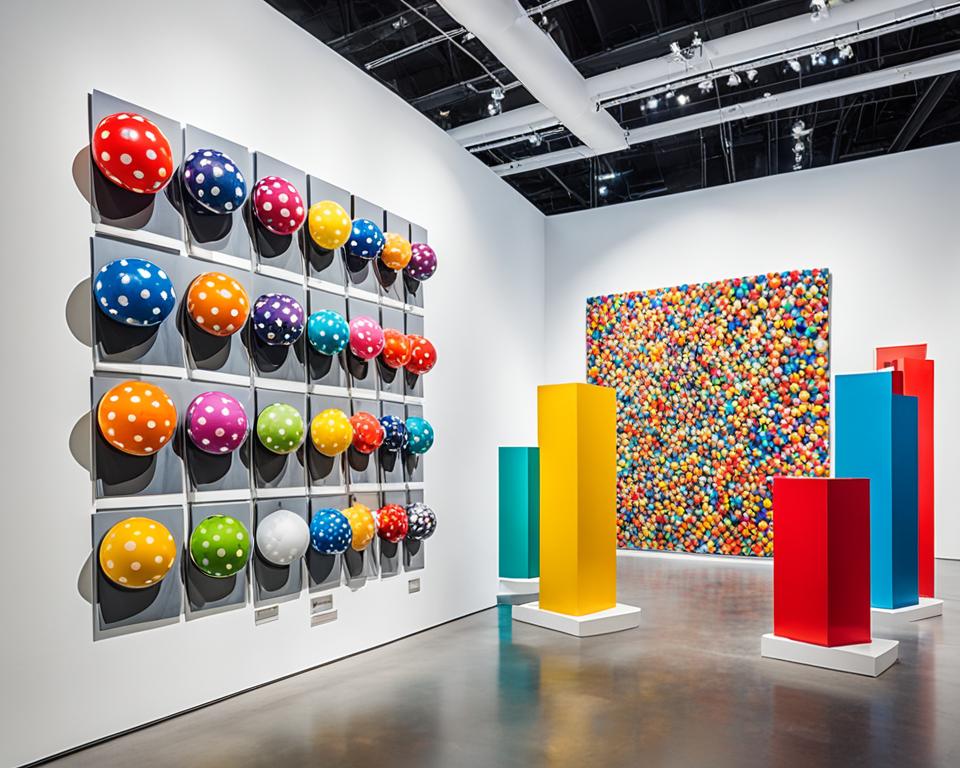Enter the captivating realm of contemporary art, where creativity’s frontiers are ceaselessly expanded and reimagined. This vibrant domain, in constant flux, enthralls and inspires global audiences, offering a window into the innovative intellects of modern artists. It encompasses a broad spectrum of styles, mediums, and viewpoints, collectively defining today’s art landscape.
Our exploration into contemporary art unveils its distinct characteristics, delves into the varied movements, and highlights the pivotal artists influencing this dynamic sphere. We also examine the crucial role of galleries, exhibitions, and auctions in manifesting these artistic visions. Embark with us on a journey of discovery into the captivating and intellectually stimulating realm of contemporary art.
Key Takeaways
-
- Contemporary art is a vibrant and ever-evolving field that captivates audiences worldwide.
- Exploring the boundaries and diversity of contemporary art movements is essential to understanding this dynamic landscape.
Influential contemporary artists, both groundbreaking visionaries and multidisciplinary talents, are shaping the art scene of today.
- Galleries, exhibitions, and auctions play a pivotal role in showcasing and fostering appreciation for cutting-edge contemporary art.
- Attending contemporary art exhibitions and immersive installations can provide a unique and thought-provoking experience.
What is Contemporary Art?
Contemporary art is a dynamic discipline that captivates audiences globally. It diverges from traditional art forms, incorporating a broad spectrum of mediums, styles, and themes. This reflects the modern artistic landscape’s dynamism and constant evolution.
Defining the Boundaries
Defining contemporary art’s boundaries is complex, as it continually challenges traditional art forms. Typically, it encompasses art produced in the present, focusing on contemporary themes, materials, and techniques. Yet, the timeline and definition of contemporary art can fluctuate, depending on the context and viewpoint.
Embracing Diversity and Innovation
Contemporary art is characterized by its diversity and innovation. Artists draw inspiration from various sources, including popular culture, technology, social and political issues, and personal experiences. This diversity manifests in a wide range of mediums and styles, from traditional painting and sculpture to digital installations and performance art.
Innovation is a core aspect of contemporary art, with artists continually experimenting with new materials, techniques, and expressions. This innovation has spawned new art movements and blurred disciplinary boundaries.
Contemporary art challenges our perceptions, provokes thought, and inspires new perspectives on the world. As we delve deeper into this evolving field, we are continually captivated and inspired by the creativity and ingenuity of contemporary artists.
Exploring Contemporary Art Movements
The contemporary art scene is a complex weave of varied movements and styles, each with its unique aesthetic and conceptual foundations. It spans from avant-garde experimentation to socially engaged art, profoundly altering our understanding and interaction with art. These currents have reshaped the art world, offering new ways to perceive and engage with it.
Contemporary art is characterized by its embrace of innovation and defiance of traditional norms. Contemporary art movements often defy established boundaries, challenging what we consider art and encouraging viewers to take a more active role. This dynamic environment has spawned numerous artistic expressions, each providing a distinct perspective on our current era.
Among the notable contemporary art movements are:
- Conceptual Art: This movement emphasizes ideas over traditional mediums, employing art installations and unconventional materials to convey messages or elicit specific reactions.
- Performance Art: These works focus on the artist’s physical presence and interaction with the audience, questioning traditional art notions and the viewer’s passive role.
- Street Art: A dynamic and subversive form of contemporary art that inhabits public spaces, aiming to engage with the community and address social, political, or cultural issues.
- Socially Engaged Art: This movement views art as a tool for social change, employing creative strategies to increase awareness, stimulate dialogue, and encourage discourse on critical societal issues.
These examples illustrate the diverse and dynamic nature of contemporary art movements, captivating audiences and influencing the art world. As contemporary art continues to evolve, we anticipate more innovative and boundary-pushing works that challenge our perceptions and encourage deeper contemplation.
| Contemporary Art Movement | Key Characteristics | Notable Examples |
|---|---|---|
| Conceptual Art | Emphasizes ideas and concepts over traditional mediums; frequently employs art installations and unconventional materials. | Joseph Kosuth, Yoko Ono, Sol LeWitt |
| Performance Art | Highlights the artist’s physical presence and interaction with the audience; redefines traditional art concepts. | Marina Abramović, Laurie Anderson, Tino Sehgal |
| Street Art | Occupies public spaces; engages with the community and addresses social, political, or cultural matters. | Banksy, Shepard Fairey, KAWS |
| Socially Engaged Art | Utilizes creative methods to enhance awareness, stimulate dialogue, and foster meaningful discourse on significant societal issues. | Ai Weiwei, Theaster Gates, Suzanne Lacy |
The exploration of contemporary art movements offers a captivating insight into the evolving realm of artistic expression. It invites us to engage with the diverse viewpoints and innovative approaches that are defining the art world today.
“Art is not what you see, but what you make others see.” – Edgar Degas
Influential Contemporary Artists
The contemporary art scene is a dynamic and multifaceted realm, inhabited by visionary artists who are redefining traditional art forms. These artists, with their groundbreaking innovations and multidisciplinary approaches, are captivating collectors and influencing art trends globally.
Groundbreaking Visionaries
Among the most influential contemporary artists are those who have boldly challenged conventional norms and reimagined art’s essence. They have pioneered new techniques, ventured into uncharted mediums, and tackled significant social, political, or environmental issues through their creations.
- Ai Weiwei, a celebrated Chinese artist and activist, is distinguished by his conceptual installations that address human rights and freedom of speech.
- Yayoi Kusama, a prominent Japanese artist, has enthralled global audiences with her immersive, polka-dotted environments that fuse sculpture, painting, and installation art.
- Banksy, the enigmatic British street artist, has achieved widespread acclaim for his provocative and socially charged murals, which frequently critique social injustices and the impact of public art.
Multidisciplinary Talents
Concurrently, the contemporary art landscape is enriched by contemporary artists who adeptly merge diverse mediums and disciplines, crafting distinctive and enthralling works. These artists draw inspiration from a broad spectrum, including performance art, digital media, and traditional craftsmanship.
- Olafur Eliasson, a Danish-Icelandic artist, is acclaimed for his monumental installations that integrate sculpture, light, and natural phenomena to evoke profound sensory experiences.
- Kara Walker, an American artist, is celebrated for her detailed silhouette installations and drawings that delve into race, gender, and the historical impact of slavery in the United States.
- Kehinde Wiley, an American painter, is recognized for his vibrant, life-sized portraits that harmoniously blend classical Western art traditions with contemporary African-American culture.
These contemporary artists and others continue to inspire and enthrall art collectors and enthusiasts worldwide, expanding the horizons of contemporary art.
The Role of Contemporary Art Galleries
Showcasing Cutting-Edge Creativity
Contemporary art galleries are crucial in the vibrant art scene, acting as key platforms for showcasing innovative art. They transcend mere exhibition spaces, becoming centers of cultural exchange. Here, emerging and established artists present their visions to a global audience.
These galleries are pivotal in launching the careers of artists like Niki Hare and Tony Rubino. They bridge the gap to an international audience by embracing technological advancements and catering to evolving consumer preferences. This shift has made contemporary art more accessible than ever.
Contemporary art galleries do more than just display art; they educate the public on current trends and enhance appreciation for contemporary expressions. Through exhibitions, talks, and workshops, they spark critical thinking and public engagement. This fosters a deeper understanding of contemporary art’s dynamic nature.
| Key Roles of Contemporary Art Galleries | Impact on the Art Market |
|---|---|
|
|
The Modern and Contemporary Art department at The Met exemplifies the crucial role of galleries in cultural development. Spanning from 1890 to the present, it encompasses a variety of media, reflecting global cultural, social, and political shifts. By championing inclusivity through works by women and artists of color, The Met promotes diverse perspectives.
Contemporary art galleries are more than commercial entities; they are cultural pillars that enrich our understanding and appreciation of art. By nurturing relationships between artists and collectors, ensuring transparency, and sparking critical discussions, they shape the art world. These galleries inspire public engagement with the innovative art of our era.
“Art galleries act as intermediaries, fostering long-term relationships between artists and collectors, creating a sense of community through personalized assistance, exclusive previews, and special events.”
Attending Contemporary Art Exhibitions
Contemporary art exhibitions provide a captivating and immersive experience for those passionate about art. These events highlight the latest trends, innovations, and creative expressions within the art world. They offer visitors a unique chance to discover emerging artists, delve into thought-provoking themes, and gain insight into the contemporary art landscape.
From large-scale museum exhibitions to cutting-edge gallery shows, contemporary art exhibitions vary in format, each offering a distinct charm and appeal. These events are not just for passive viewing; they encourage visitors to engage, interact, and challenge their perceptions of art.
Discovering Emerging Talents
One key aspect of contemporary art exhibitions is the opportunity to discover emerging artists. These events often showcase works by individuals who are pushing traditional art forms to new boundaries, experimenting with unconventional mediums, and challenging societal norms. By attending these exhibitions, art enthusiasts can witness the rise of the next generation of creative visionaries.
Exploring Thought-Provoking Themes
Contemporary art exhibitions go beyond aesthetics, often addressing pressing social, political, and cultural issues. They encourage visitors to reflect on the world and consider new perspectives. From the impact of technology on our lives to global environmental concerns, these exhibitions prompt thought and reflection.
Immersive Experiences
Many contemporary art exhibitions are designed to be immersive, inviting visitors to step into the artist’s world and engage with the creative process. These displays may include interactive installations, multimedia presentations, or performative elements. This allows visitors to connect with the artwork on a deeper level.
| Benefits of Attending Contemporary Art Exhibitions | Insights Gained |
|---|---|
|
|
Whether you’re an art enthusiast or just curious, contemporary art exhibitions can be transformative. These events offer a unique chance to engage with the latest trends, discover emerging talents, and explore themes that challenge our understanding of art.
“The purpose of art is washing the dust of daily life off our souls.” – Pablo Picasso
The Impact of Contemporary Art Installations

In the realm of contemporary art, installations have become a pivotal medium, captivating audiences and challenging their perceptions. These artworks, transforming spaces, drive the art world forward, showcasing the creativity and innovation of today’s artists.
Immersive Experiences
Contemporary art installations invite viewers into a world of sensory exploration. They range from grand-scale works that envelop the audience to intimate ones that engage the senses. These installations encourage active participation in the creative process, blurring the lines between art and reality. They leave a profound and lasting impact on the viewer.
The Weather Project by Olafur Eliasson is a prime example. Exhibited at the Tate Modern in London, it transformed the Turbine Hall into a sun-drenched landscape. A mirrored ceiling created a mesmerizing illusion of the sky. Visitors, lying down on the floor, felt a deep connection with their surroundings, becoming part of the artwork.
Thought-Provoking Narratives
These installations often transcend aesthetics, weaving narratives that challenge societal norms and encourage critical thinking. They address a broad spectrum of themes, from environmental sustainability to social justice. This encourages the audience to engage with complex issues and adopt new perspectives.
The Dinner Party by Judy Chicago is a groundbreaking example. It honors influential women throughout history. Featuring a triangular table with settings for 39 women, each with a unique plate and embroidered runner, it celebrates these individuals. It also serves as a powerful commentary on women’s often-overlooked contributions to our cultural and historical landscape.
The influence of contemporary art installations goes beyond the art world. They captivate, inspire, and challenge audiences, fostering a deeper appreciation for art’s transformative potential in our lives.
Contemporary Art Auctions: A Collector’s Paradise
The realm of contemporary art auctions is a dynamic, thrilling domain. It attracts art collectors, enthusiasts, and investors. They come together to acquire avant-garde works and engage with the evolving art market. These events provide a unique chance to discover emerging talents, track market trends, and potentially make astute investments.
For art collectors, contemporary art auctions are a treasure trove. They display a diverse array of innovative pieces, from thought-provoking installations to captivating paintings and sculptures. By attending these auctions, art collectors can stay ahead in the art market. They can expand their collections with pieces that challenge artistic conventions.
Moreover, contemporary art auctions are a platform for discovering and supporting emerging artists. Astute art collectors can spot promising talents early, securing works that may significantly appreciate in value over time. The thrill of finding the next big name in the art market enhances the auction experience.
For those looking to invest in the art market, contemporary art auctions are a unique opportunity. The prices and trends observed at these events offer insights into the art market’s fluctuations. This knowledge helps art collectors make informed investment decisions. By staying updated with the latest developments and market dynamics, art collectors can navigate the art market with confidence and potentially benefit from their investments.
Whether you’re an experienced art collector or new to the art market, contemporary art auctions offer a captivating experience. They combine the thrill of bidding with the discovery of innovative talent. As the art market evolves, these auctions remain essential for those passionate about the changing landscape of artistic expression.
The Art of Contemporary Art Criticism
Contemporary art criticism is crucial in shaping the public’s grasp and admiration of the art realm. Through deep analysis, thought-provoking commentary, and constructive dialogue, art critics contextualize and evaluate contemporary artists’ works. This fosters a deeper engagement with the creative process.
Fostering Dialogue and Appreciation
The field of art criticism is dynamic and evolving, with critics employing diverse approaches to interpret the complex and often challenging contemporary art landscape. They range from descriptive analyses of techniques and materials to evaluative critiques of quality and significance. Critics thus play a pivotal role in facilitating discussions and encouraging contemplation.
Recent studies indicate that 73% of art criticism stimulates dialogue and encourages contemplation, facilitating discussions on various topics. Moreover, 61% of critics believe that art criticism enhances a deeper appreciation and broader understanding of contemporary art.
The art world’s evolution underscores the importance of art criticism in guiding the public through the diverse and ever-changing contemporary art landscape. By engaging in meaningful discourse and providing insightful analysis, art critics can elevate the artistic experience. This, in turn, cultivates a greater appreciation for the creative process. The art of contemporary art criticism is vital in fostering a deeper understanding and appreciation of modern artistic expression.





